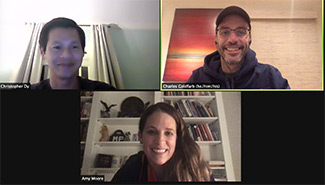Dr. Chuck and the Pod People
St. Louis Shriners Hospital Surgeon Attracts an Audience with Podcast
It’s a Saturday afternoon and Charles Goldfarb, M.D., is in his basement cracking himself up.
Upstairs, his wife, Talia, knows exactly what’s going on: Her husband is editing his podcast again.
Chuck, as Dr. Goldfarb is known to just about everyone, is a nationally renowned hand surgeon at Shriners Hospitals for Children — St. Louis, and co-hosts the weekly podcast The Upper Hand with Chris Dy, M.D., a fellow surgeon and professor at Washington University Department of Orthopaedic Surgery. The pod, as the cool people call them, just entered its second year.
“My wife can’t understand how I can find myself so funny, but I love doing this podcast,” said Dr. Goldfarb via a Microsoft Teams call a few minutes after finishing a day of helping patients in hospital clinic.
For non-podcast people, a podcast is a digital audio file, usually a series, about some topic or another that listeners consume mostly via a smartphone app. The biggest genre is true crime, but there are podcasts for everything from fans of the role-playing game Dungeons & Dragons to popular sports with hosts such as former heavyweight boxing champion Mike Tyson or ESPN’s PTI co-host Tony Kornheiser. If there’s a group of people who share an interest in something, there’s probably a podcast for it.
Drs. Goldfard and Dy aim their podcast at fellow hand surgeons, physical therapists and would-be surgeons of the future. Along the way, they have picked up current patients as fans, and even attracted some new patients to the St. Louis Shriners Hospital.
Listenership has grown exponentially in the first year, from a handful of downloads at the start – mostly friends and colleagues – to more than 1,000 downloads each week as the surgeons sewed up their first year as podcasters. While The Upper Hand podcast comes with a tagline of “Chuck and Chris Talk Hand Surgery,” their show is about more than the particulars of fixing upper extremity issues. Topics over the show’s first 50-plus episodes include what can be learned when surgeries don’t go as planned, and side gigs that can help surgeons avoid burnout – like, for instance, podcasting.
Those who sample The Upper Hand with select episodes from the beginning, middle and end of the first year will notice one thing was there from the start: the chemistry between the two hosts. Dr. Dy, who was once a fellow for his co-host, helps create what Dr. Goldfarb calls, “a nice young guy/old guy shtick.”
Said Dr. Dy: "Chuck brings a ton of experience to the table. I try to bring the perspective of being a recent trainee and somebody who is still in the steep learning curve of my practice. I think these contrasting perspectives are really helpful for the audience."
If you’re attentive enough as the season progresses, you will, however, notice a few things have changed.
“When we first started, our listeners would say (Dr. Dy) was overly deferential to me. That’s disappeared, but not in a bad way,” said Dr. Goldfarb, an Alabama native and father of three – a boy in college and two girls working their way through high school.
Both co-hosts long ago became comfortable with public speaking, having given talks on the national level in front of huge audiences of super-smart colleagues. But putting a microphone in front of anyone and clicking the “record” button creates a completely different dynamic.
“Like anything, you become more comfortable with repetition,” Dr. Goldfarb said. “The words come more easily now.”
The operation remains extremely low-budget. When the venture started, the duo recorded in Dr. Goldfarb’s basement using the only pieces of equipment purchased to make it happen – two microphones. Recording sessions occur whenever schedules happen to line up each week. Sometimes that’s 9 p.m. on a Wednesday. Sometimes it’s 6 a.m. Saturday.
From there, Dr. Goldfarb handles all the editing, which leads to his laughter at his own witticisms and Talia’s eye-rolls. Dr. Dy posts the episodes and handles social media promotion.
“What’s cool is just exploring this new world,” said Dr. Goldfarb, who isn’t new to reaching beyond the operating room with different forms of media; he also is the author of a blog aimed at patients, The Congenital Hand, which has more than a million hits since its inception in 2011. “This is so different from what I do every day. It’s fun and helps keep me going in this crazy world of the pandemic.”
That pandemic has forced the two to record from their own home bases via Zoom, but this setup has made it easier to have guests on the show. Last week’s pod featured Amy Moore, M.D., a plastic surgeon with expertise in nerve transfer surgery.
As far as what comes next, Dr. Goldfarb said he’s focused on analyzing the data from the podcast’s downloads to see what works best. He and Dr. Dy have no plans of stopping the momentum they’ve built, despite taking a two-week break after Season 1.
“We both missed it when we weren’t doing it,” Dr. Goldfarb said. “As long as we are learning and having fun, and we both are, then it’s a value-add to our lives. It’s a way to reach out and spread knowledge and help kids in the process.”
Check out The Upper Hand podcast on Spotify or wherever podcasts are posted.

Keep In Touch
Join our mailing list to stay up to date on everything that's happening at Shriners Children's.
